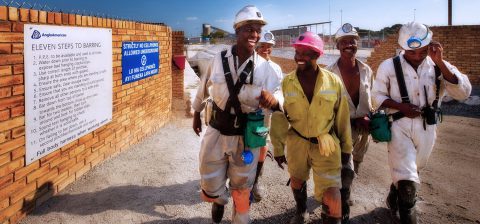SA Mining
Funding Fiasco: Junior Miners In A Jam
Without junior miners there would be no mining, large-scale or otherwise.
The junior mining sector remains the backbone of the resources sector. Renergen CEO Stefano Marani explains it this way: if a country doesn’t have explorers discovering and upgrading resources, the mining sector in that country dies. “This is analogous to a country with a zero birth rate,” he says.
It is therefore imperative to continually invest in exploration, which translates into a strong pipeline of projects for the future, given that “established mines eventually run out once the mine reaches its end of life”.
However, in most resource-rich regions of the world, the junior mining sector is also the most vulnerable as it remains at the mercy of commodities prices and political and regulatory influences. When prices soar, investment is forthcoming, but in lean times, it is the sector most sacrificed, as it has been for the past number of years.
SA Mining recently spoke to junior miners with projects in Africa and South Africa, including Renergen’s Marani, West African gold explorer Mako Gold’s Peter Ledwidge, Botswana coal developer Minergy’s Andre Bojé and the Chamber of Mines head of the Emerging Miners’ Desk Grant Mitchell, to get a first-hand view of the challenges faced by the sector.
Funding fiasco
Whether locally or in Africa, access to funding for project development remains the single biggest challenge, they agree.
According to the CoM’s Mitchell, financial institutions such as banks and the Industrial Development Corporation (IDC) are actually risk-averse “when it comes to making venture capital available for the development of small-scale projects”. “This is largely because the government does not offer any tax incentives to investors in prospecting companies hence the investors carry all the risk. These companies are after all looking for new reserves which then become a national asset.”
“Raising capital for the exploration and construction phases of a project is a huge challenge. To mitigate this challenge, government together with financial institutions such as the Public Investment Corporation (PIC) and IDC need to develop an appropriate funding model,” says Minergy’s Bojé.
The emerging coal mining company Minergy owns the Masama project which is located in the Mmamabula Coalfield of Botswana. It is currently in the development phase and scheduled for production during the last quarter of this year.
Further to this, the sector competes directly with others that are more attractive to investors, says Renergen’s Marani. Renergen is South Africa’s first listed alternative and renewable energy company whose flagship project, Virginia, in the Free State, expects to be in liquefied natural gas production by 2019. “If you are a fund manager in SA, why would you invest in junior mining given the challenges associated with regulatory uncertainty, labour disruptions and ageing infrastructure, among others, when you can invest in sectors that face significantly less regulation such as property or fast-moving consumer goods sectors?”
Moreover, the perception of South Africa’s mining sector as a sunset industry means that international investors are reluctant to make investments in local junior mining ventures. “Without junior mines coming online, only old mines already producing cash flow are given any support, with the result that the perception is becoming a self-fulfilling prophecy,” says Marani.
Furthermore, junior miners who are intent on speedily developing their projects compete head-on for financial assistance with peers whose projects remain undeveloped for up to 10 years. “It is definitely difficult to convince investors that your project is worthy of financial injection above others,” says Mako Gold’s Ledwidge.
Mako Gold has early-stage exploration projects in West Africa and is busy gearing up for drilling on its flagship project, Napié, in Ivory Coast, in the hopes of making a new discovery. Ledwidge is the former business development manager of Orbis Gold, which discovered the Boungou deposit and advanced it to resource and scoping study, and subsequently sold it to SEMAFO. The company expects the Boungou Mine to go into production later this year.
According to Ledwidge, investors are clearly more inclined to invest in projects and teams that have a track record for being successful. However he explains that not all international investors have a clear understanding of projects in Africa as “some investors view the continent as a single entity and are therefore reluctant to invest, given the negative publicity associated with perceived political instability and/or governance-related matters, such as changes in the mining codes, which are seen to adversely impact the entire continent”.
Owing to this perception, Australian companies with projects in Africa remain united in promoting the continent as an attractive investment destination to ensure that “money remains in Africa”, he says. “Furthermore, Australian junior miners choose to work with brokers that have an investor base well versed in investing in Africa.”
Regulatory rigmarole: Are governments lending a helping hand?
Political and regulatory influences remain a key factor affecting a junior miner’s ability to flourish.
“Governments of African countries are often unable to invest in mining projects, unlike their Australian counterpart, which looks instead to grow its junior mining sector by offering, among others, grants for the development of infrastructure such as roads and power. These developments are viewed as benefiting the country as a whole,” says Ledwidge. “But the fact is, many African countries simply lack the financial resources to invest in these projects. In my experience in Burkina Faso and Côte d’Ivoire, the countries’ administration is very supportive of the industry but cannot assist financially.”
According to Bojé, the government of Botswana works tirelessly to promote junior mining and plays an active role in assisting wherever possible. As the former founder of Wescoal, a South African coal producer, and now a Botswana coal operator, Bojé has experience operating in both the South African and Botswana environments.
“The most glaring difference is legislation – in South Africa there is vast scope for administrative discretion whereas in Botswana this has largely been removed. In addition, issues and challenges in Botswana are jointly addressed by industry and the relative departments, whereas in South Africa, issues and challenges are used as a stick to beat industry into line, for example, the issuing of section 54 notices at a whim, threatening to cancel licences, or withdrawing previously issued permits,” he says.
Mitchell says positive government intervention is critical for promoting junior mining. However a regulatory environment favouring junior miners is non-existent in South Africa, he says.
In fact Marani describes the local regulatory environment as one which is high-risk and hampers investment in the sector.
“Between the revised BEE charters, constantly updated MPRDAs and fighting between the Chamber of Mines and the incumbent government trying to achieve its own agenda of winning populist votes, South Africa is perceived as a very high-risk jurisdiction for mining, which is highly regulated to begin with.
“We are therefore seen as among the worst mining destinations globally for new projects, therefore capital favours places like Australia, South America and other African countries, which are much hungrier for the economic growth generated by mining. Ultimately investors want the goal posts to remain fixed, and South Africa cannot offer that.”
Given the additional financial burden of navigating an over-regulated environment, it is no surprise that junior miners in South Africa take far longer to reach production than those in more attractive mining jurisdictions, says Marani. He says self-regulation tends to be more effective than over-regulation, and simpler, better-thought-out rules would be a major boost for junior miners.
Apart from regulatory inconsistencies related to the awarding of mining licences, the Department of Mineral Resources (DMR) has not been sensitised towards understanding the challenges faced by the junior miners, especially regarding time and financial constraints.
Mitchell explains that a delay in attaining mining licence approval has huge financial impacts on a junior miner’s ability to remain open for an extended period as it exists on borrowed time and capital. “The time that it takes from mining licence application to award is simply far too long, and can sometimes take years instead of months,” he says.
Furthermore, the various departments – including the DMR and departments of Water Affairs and Forestry, and Environmental Affairs – operate independently, and in many instances contradict each other. “To mitigate such challenges the DMR must move towards a single integrated application that takes no longer than 300 days to completion, as promised by (previous mining minister) Susan Shabangu,” notes Bojé.
Another bone of contention is the DMR’s outdated paper-based system which doesn’t allow potential applicants access to property rights.
The DMR needs to ensure transparency of the mineral rights system, says Mitchell, explaining that a computerised online system outlining mineral ownership would fast-track the mining rights and environmental impact assessments rights approval process.
Most importantly, there is urgency to finalise the Mining Charter given that junior miners “will never attract equity and technical partners until the charter is resolved”, says Bojé. Mitchell notes that junior miners have taken the bull by the horns and are making a play at drafting their own position on the charter, including the need to have a “staggered system” into the charter.
Poor infrastructure and labour disruptions
Apart from financial and regulatory challenges, the junior mining sector remains hampered by poor infrastructure. “Ageing infrastructure and access to, for instance, grid power for small projects remains a stumbling block,” says Marani. “This means that new projects must use more expensive forms of energy at the outset, which dilutes economics.”
He highlights work disruptions by labour and labour unions as further challenges impacting the sector. “Due to the lack of mechanisation, the cost of operating in South Africa is higher relative to our competitors, which means a significant portion of natural resources remains economically unviable,” he says.
Light at the end of the tunnel?
It is hoped that the change in guard in the form of Gwede Mantashe as Mineral Resources minister will result in a more progressive sector open to advancing growth and prosperity in the junior mining sphere.
According to the experts quoted in this article, advancing the junior mining sector would significantly increase contribution to gross domestic product, offer much-needed employment in the face of the high unemployment rate in the country and provide training and skills development opportunities for new recruits.
“Junior miners are not the enemy – they are the future of mining in Africa,” says Bojé.







 Sign-up and receive the Business Media MAGS newsletter OR SA Mining newsletter straight to your inbox.
Sign-up and receive the Business Media MAGS newsletter OR SA Mining newsletter straight to your inbox.